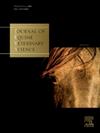Bacterial prevalence in equine semen
IF 1.3
3区 农林科学
Q2 VETERINARY SCIENCES
引用次数: 0
Abstract
Stallion semen contains a high prevalence of contaminating bacteria from the external genitalia during collection (Rota et al., Theriogenology 2011;76:464-70). These bacteria can induce endometritis in mares predisposed to infections after insemination and can have a deleterious effect on the quality of preserved sperm, affecting their viability and fertility (Samper & Tibary, Theriogenology 2006;66:551-9). In addition, some reports have demonstrated the detrimental effects of some bacteria, such as Pseudomonas aeruginosa or Streptococcus equisimilis on the motility and membrane integrity of equine sperm (Aurich & Spergser, Theriogenology 2007;67:912-8). This study aimed to assess bacterial and fungal prevalence in semen from Mangalarga Marchador stallions. Eight stallions were evaluated at random at different stud farms in the state of Rio de Janeiro, Brazil. After washing the penis with water, semen was collected using a Hannover model artificial vagina. A swab was then submerged in the semen, preserved, transported, and refrigerated in Stuart medium until it was sent to the reproduction laboratory. After incubation for 24 hours at 37°C, bacterial plating was carried out on blood agar, MacConkey agar and Chromagar, and fungal plating on Sabouraud medium. After 24 hours of culture, identification was made by morphology and Gram staining. Of the eight stallions evaluated, five (63%) had bacteria in their semen. The bacteria found were Streptococcus spp., Escherichia coli, and Klebsiella spp. (Scholtz et al., Equine Vet J. 2024;1–11). Streptococcus spp. was isolated in 50% of the stallions (4/8), Escherichia coli in 38% (3/8) and Klebsiella sp. in 13 % (1/8) of the samples. Mixed bacterial growth was identified in 38% (3/8) of the samples, two of them were Streptococcus spp. and Escherichia coli and one Streptococcus sp. and Klebsiella sp, respectively. There was no fungal growth in the samples analyzed. Our results are compatible with the bacterial isolates found in a study carried out in Sweden with a total bacterial prevalence of 59%, 53% being Klebsiella pneumoniae, 80% beta-haemolytic Streptococcus and 43% Pseudomonas aeruginosa (Al-Kass, et al, Acta Veterinaria Scandinavica, 2019). It is concluded that bacterial presence in stallion semen should be investigated before it is used in the breeding season.
马精液中的细菌流行率
在采集过程中,种马精液中含有大量来自外生殖器的污染细菌(Rota等人,Theriogenology 2011;76:464-70)。这些细菌可诱发受精后易受感染的母马子宫内膜炎,并可对保存精子的质量产生有害影响,影响其生存能力和生育能力(Samper &;图书馆,遗传学2006;66:551-9)。此外,一些报道已经证明了一些细菌,如铜绿假单胞菌或马链球菌对马精子的活力和膜完整性的有害影响(Aurich &;Spergser, Theriogenology; 2007;67:912-8)。本研究旨在评估Mangalarga Marchador种马精液中细菌和真菌的流行情况。在巴西里约热内卢州的不同种马场随机评估了8匹种马。用水冲洗阴茎后,用汉诺威人工阴道模型收集精液。然后将拭子浸没在精液中,保存,运输,并在Stuart培养基中冷藏,直到它被送到生殖实验室。37℃孵育24小时后,在血琼脂、MacConkey琼脂和Chromagar上进行细菌电镀,在Sabouraud培养基上进行真菌电镀。培养24小时后,通过形态学和革兰氏染色进行鉴定。在接受评估的8匹种马中,有5匹(63%)的精液中含有细菌。发现的细菌为链球菌、大肠杆菌和克雷伯氏菌(Scholtz et al., Equine Vet J. 2024; 1-11)。50%(4/8)种马检出链球菌,38%(3/8)种马检出大肠埃希菌,13%(1/8)种马检出克雷伯菌。38%(3/8)的样品中检出混合细菌生长,其中2例为链球菌和大肠杆菌,1例为链球菌和克雷伯氏菌。在分析的样品中没有真菌生长。我们的结果与瑞典进行的一项研究中发现的细菌分离株相一致,该研究中发现的细菌总患病率为59%,其中53%为肺炎克雷伯菌,80%为溶血性链球菌,43%为铜绿假单胞菌(al - kass等人,Acta Veterinaria scandinavia, 2019)。因此,在繁殖季节使用种马精液前,应先对其细菌含量进行调查。
本文章由计算机程序翻译,如有差异,请以英文原文为准。
求助全文
约1分钟内获得全文
求助全文
来源期刊

Journal of Equine Veterinary Science
农林科学-兽医学
CiteScore
2.70
自引率
7.70%
发文量
249
审稿时长
77 days
期刊介绍:
Journal of Equine Veterinary Science (JEVS) is an international publication designed for the practicing equine veterinarian, equine researcher, and other equine health care specialist. Published monthly, each issue of JEVS includes original research, reviews, case reports, short communications, and clinical techniques from leaders in the equine veterinary field, covering such topics as laminitis, reproduction, infectious disease, parasitology, behavior, podology, internal medicine, surgery and nutrition.
 求助内容:
求助内容: 应助结果提醒方式:
应助结果提醒方式:


